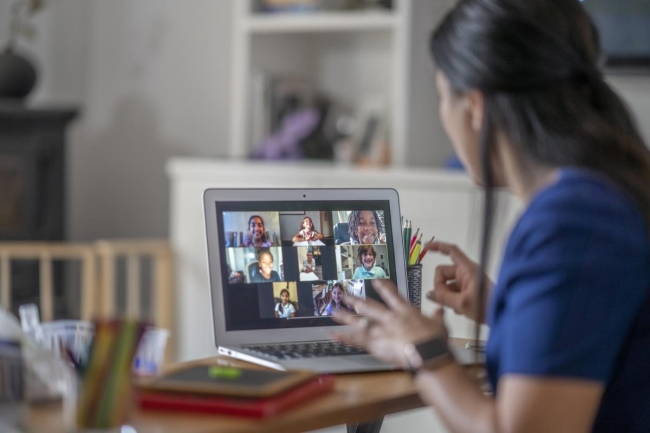You have /5 articles left.
Sign up for a free account or log in.

Colleges across the U.S. are further delaying in-person classes due to rising coronavirus cases.
Getty Images
Colleges that temporarily shifted instruction online due to the surging Omicron variant of the coronavirus now face the question of when to resume in-person learning. For a growing number of institutions, the answer is not yet.
Eight institutions in the University of California system—Berkeley, Davis, Irvine, Los Angeles, Merced, Riverside, San Diego and Santa Cruz—all operating remotely, extended those plans to late January, delaying a return to physical classrooms. Duke University and Seattle University, both of which began the semester with online classes, have also announced plans to extend the remote instruction period.
Likewise, multiple schools in the California State University system also announced a late return to in-person classes.
Stanford University announced a one-week extension of online learning for most undergraduate classes, the San Francisco Chronicle reported. Instead of two weeks of online learning, students will now have three weeks.
While multiple California institutions announced these plans last week, Duke University made the move on New Year’s Eve, delaying the end of remote instruction from Jan. 10 to Jan. 18.
“We are trying to minimize the disruption to classes that would be caused by large numbers of students testing positive on return and needing to be isolated for 5-10 days depending on their condition,” Erin Kramer, Duke’s assistant vice president of media relations and public affairs, wrote in an email. “That is why we started online and asked students to delay their arrival back to campus (which is otherwise open).”
Seattle University made the call to extend remote instruction early last week.
“Over the Christmas break, we announced that Seattle University would begin the new year in a mostly virtual learning environment,” President Eduardo M. Peñalver wrote in a message to campus. “The decision was based on the rapid spread of the Omicron variant of COVID-19 in the state of Washington, across the United States and globally. In light of the continuing and rapid spread of Omicron, we have decided to extend the timeframe for remote learning through January 30, 2022. We will return to in-person classes beginning Monday, January 31, 2022.”
Seattle University spokesperson Lincoln Vander Veen said the move aims to “prevent undue disruption and confusion as we navigate the next few weeks,” noting “significant increases in the region.” Making the decision sooner, he says, allowed the university to adequately plan for virtual learning rather than being forced to quickly pivot to remote instruction.
More colleges have since joined the ranks of institutions pushing back the dates of in-person classes, including Cornell University, the University of Southern California and others.
Making the Decision
Colleges are citing spiking numbers and breakthrough infections as factors in staying online.
At UC Irvine, for example, Chancellor Howard Gillman said the testing positivity rate for campus community members is over 13 percent. Off campus in Orange County, the positivity rate is even higher, over 25 percent, he said in an announcement. “That is simply too much disease transmission both on campus and in the community to assume safe in-person interactions,” it read.
David Souleles, director of the UC Irvine COVID-19 response team, said via email that the university considered metrics such as the testing positivity rates and daily cases reported for both the campus and the county, as well as the community transmission levels of coronavirus cases, as tracked by the Centers for Disease Control and Prevention website.
At UC San Diego, officials noted that simulation models indicate peak infections will happen in mid-January, which was a factor in the decision to remain remote through Jan. 31.
“Extending the mandatory remote instruction period until the end of January allows UC San Diego to keep teaching modalities as simple as possible given that many students, faculty and staff may still be sick or recovering in the second half of the month or experiencing extra caregiving responsibilities,” a university spokesperson wrote in an email. “The decision also provides more time for students, faculty and staff who are eligible to schedule and receive a vaccine booster before returning to campus.”
The university added it is “experiencing staffing shortages similar to other employers” and that “a number of students are exposed to COVID, impacting their ability to attend classes in person.”
The National Norms
Data collected and crunched by the College Crisis Initiative, or C2i, at Davidson College, show that more than 88 percent of the 502 schools in the research center’s sample are returning to physical classrooms, with almost 12 percent opting for a remote spring semester.
The research, completed last week, found that 98 percent of colleges plan to start on time. However, C2i assistant director Rylie Martin told Inside Higher Ed last week that she expected more colleges to fine-tune their plans in the coming days as the spring semester draws closer.
Emily Oster, an economics professor at Brown University, has been critical of colleges shifting to remote instruction at this stage of the pandemic with vaccinations widely available.
Oster said in an email that she was unsurprised by remote instruction extensions. “In at least some cases, when initial plans to be remote were announced, universities didn’t clearly articulate why or what metric they would use to return. Given that, it isn’t surprising that we see extensions.”
Oster has argued that colleges responding to Omicron by going online are overly cautious and overlooking other student needs, such as mental health issues exacerbated by COVID-19. Given the proven efficacy of vaccines, she believes colleges are shortchanging students with remote classes.
She noted that with so many universities mandating COVID-19 vaccines, the risks are fairly low.
“My sense is many universities are concerned about spread outside of campus, although in an area with high vaccination levels this is also unlikely to cause significant issues,” Oster said. “In areas with lower vaccination levels, this may be more of a concern, although I’m concerned about a precedent in which the well-being of college students is sacrificed to protect individuals who have chosen to remain unvaccinated.”
In the meantime, universities will continue to keep an eye on the metrics to gauge whether they can reopen physical classrooms to students or once again extend the remote instruction period.
“UC San Diego’s leading-edge Return to Learn program remains focused on maintaining the health and well-being of our community through innovative solutions, including wastewater sampling, on-campus vending machines stocked with self-administered COVID-19 tests, and expanded use of the CA COVID Notify app,” a campus spokesperson said. “Our community will continue to follow the science and collaborate on solutions as we navigate this pandemic.”








